Exploring Agra: Top Must-See Attractions
Introduction
Embarking on a journey from Delhi to Agra is like stepping back in time to an era of grandeur and opulence. This tour is a perfect escape from the bustling streets of Delhi, offering a blend of history, architecture, and culture. For travellers seeking a comprehensive experience, Delhi Agra Tour Packages are ideal, ensuring you don't miss any of the key attractions that make Agra a must-visit destination in India
1. The Majestic Taj Mahal
The Taj Mahal, a UNESCO World Heritage Site, stands as the ultimate symbol of love and architectural beauty. Commissioned by Emperor Shah Jahan in memory of his beloved wife Mumtaz Mahal, this mausoleum is an epitome of grace and grandeur.
Symbol of Love
The Taj Mahal is often referred to as a "teardrop on the cheek of time," symbolising the eternal love story of Shah Jahan and Mumtaz Mahal. Built over a span of 22 years, this white marble masterpiece attracts millions of visitors from around the world.
Architectural Marvel
The Taj Mahal is renowned for its exquisite design and intricate details. The white marble structure is adorned with semi-precious stones and intricate inlay work, showcasing the pinnacle of Mughal architecture. The symmetry, the grand dome, and the four minarets add to its magnificence.
Photography Tips
For the best photographic experience, visit the Taj Mahal at sunrise or sunset. The soft light during these times enhances the beauty of the marble, making it glow with a golden hue. Capture the reflection of the Taj Mahal in the water channels for a picture-perfect shot.
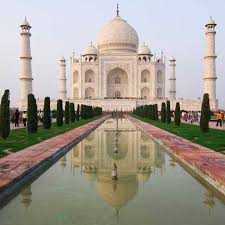
2. Agra Fort
Agra Fort, another UNESCO World Heritage Site, is a testament to the architectural brilliance of the Mughal era. This red sandstone fortress served as the main residence of the Mughal emperors until Delhi became the capital.
Historical Significance
Agra Fort has played a pivotal role in India's history. It was here that Emperor Shah Jahan was imprisoned by his son Aurangzeb. The fort has witnessed numerous battles and political events, making it a significant historical site.
Architectural Beauty
The fort is a blend of Hindu and Mughal architecture, with its massive walls, grand gates, and intricately designed palaces. The Amar Singh Gate, the main entrance, leads to a series of beautiful courtyards and halls.
Key Structures
Some of the must-visit structures within Agra Fort include Diwan-i-Am (Hall of Public Audience), Diwan-i-Khas (Hall of Private Audience), and the stunning Moti Masjid (Pearl Mosque). Each of these buildings showcases exquisite craftsmanship and architectural prowess.
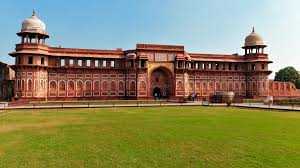
3. Fatehpur Sikri
Located around 40 kilometres from Agra, Fatehpur Sikri is a city frozen in time. Built by Emperor Akbar, this UNESCO World Heritage Site served as the Mughal capital for a brief period before being abandoned.
Abandoned Capital
Fatehpur Sikri was abandoned due to a scarcity of water, but it remains a well-preserved example of Mughal architecture. The city is a testament to Akbar's vision and architectural innovation.
Main Attractions
Key attractions in Fatehpur Sikri include the Buland Darwaza, the highest gateway in the world, Jama Masjid, and Panch Mahal, a five-story palace offering panoramic views of the city. The intricately designed palaces and courtyards are a delight to explore.
Cultural Insight
Fatehpur Sikri reflects Akbar's secular vision, with its blend of Hindu, Persian, and Islamic architectural styles. The city's layout and design offer insights into the cultural and social dynamics of the Mughal era.
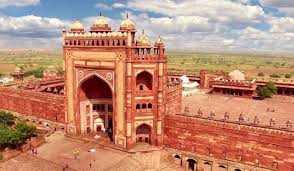
4. Itimad-ud-Daulah's Tomb
Often referred to as the "Baby Taj," Itimad-ud-Daulah's Tomb is a precursor to the Taj Mahal and a masterpiece in its own right. This beautiful mausoleum is the final resting place of Mirza Ghiyas Beg, the father of Empress Nur Jahan.
Baby Taj
Itimad-ud-Daulah's Tomb is often considered a draft of the Taj Mahal due to its similar architectural style. However, it has its own unique charm, with intricate marble lattice screens and detailed inlay work.
Mughal Gardens
The tomb is surrounded by lush Mughal-style gardens, adding to its serene ambiance. The well-manicured lawns and flowerbeds create a tranquil setting for visitors to relax and enjoy the beauty of the monument.
Intricate Design
The tomb is known for its exquisite inlay work, featuring semi-precious stones set in white marble. The detailed carvings and lattice screens make it a visual delight and a testament to Mughal craftsmanship.

5. Mehtab Bagh
Mehtab Bagh, a garden complex situated on the opposite bank of the Yamuna River, offers a stunning view of the Taj Mahal. This Mughal garden is a perfect spot for a leisurely stroll and evening photography.
Perfect Viewpoint
Mehtab Bagh provides an unobstructed view of the Taj Mahal, making it an ideal spot for photographers and nature lovers. The garden is designed to align perfectly with the Taj Mahal, offering a picturesque backdrop.
Gardens
The garden is laid out in the classic Mughal style, with symmetrical patterns, water channels, and lush greenery. It's a peaceful retreat where you can enjoy the beauty of nature and the grandeur of the Taj Mahal.
Photography Spot
For the best photography experience, visit Mehtab Bagh in the evening. The setting sun casts a golden glow on the Taj Mahal, creating a magical ambiance that is perfect for capturing stunning photographs.
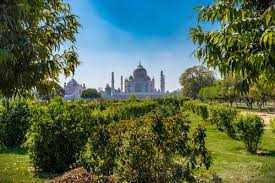
6. Akbar’s Tomb, Sikandra
Located in Sikandra, on the outskirts of Agra, Akbar’s Tomb is the final resting place of the great Mughal emperor Akbar. This impressive mausoleum is a blend of architectural styles and a symbol of Akbar’s legacy.
Resting Place of Akbar
Akbar’s Tomb is a grand mausoleum that reflects the emperor’s vision and architectural innovation. It is surrounded by lush gardens and features a series of intricately designed gateways.
Architectural Blend
The tomb is a fusion of Hindu, Christian, Islamic, Buddhist, and Jain motifs, showcasing Akbar's inclusive vision. The red sandstone structure is adorned with white marble inlays and delicate carvings.
Peaceful Ambiance
The serene gardens surrounding the tomb provide a peaceful retreat. The well-maintained lawns and tree-lined pathways create a tranquil setting, perfect for a quiet walk and contemplation.

7. Jama Masjid
Built by Shah Jahan’s daughter, Jahanara Begum, Jama Masjid is one of the largest mosques in India. This historic mosque is an architectural marvel and a place of spiritual significance.
Historic Mosque
Jama Masjid, also known as the Friday Mosque, was built in 1648. It is an important religious site and a fine example of Mughal architecture. The mosque's grand design and intricate details make it a must-visit attraction.
Architectural Grandeur
The mosque features three grand domes, a large courtyard, and an impressive prayer hall. The red sandstone structure is adorned with intricate carvings and marble inlays, reflecting the architectural prowess of the Mughal era.
Spiritual Atmosphere
Jama Masjid is not only a place of worship but also a symbol of peace and spirituality. The tranquil ambiance and the rhythmic call to prayer create a serene environment that is both uplifting and inspiring.

8. Chini Ka Rauza
Chini Ka Rauza is a unique mausoleum known for its Persian-style glazed tile work. This historic tomb is the final resting place of Allama Afzal Khan Mullah, a poet and scholar in Shah Jahan’s court.
Unique Architecture
Chini Ka Rauza stands out for its vibrant blue tiles and Persian-style architecture. The tomb's facade is adorned with colourful glazed tiles, creating a striking visual effect.
Historic Tomb
Built in 1635, Chini Ka Rauza is a fine example of Indo-Persian architecture. The tomb’s unique design and intricate tile work reflect the cultural exchange between Persia and India during the Mughal era.
Colourful Facade
The vibrant blue tiles of Chini Ka Rauza make it a unique monument in Agra. The intricate patterns and colourful designs add to its charm, making it a must-visit for history and architecture enthusiasts.

9. Mariam’s Tomb
Mariam’s Tomb is the final resting place of Mariam-uz-Zamani, the wife of Emperor Akbar and the mother of Emperor Jahangir. This elegant tomb is a fine example of Mughal architecture and a symbol of Akbar’s love for his wife.
Mughal Heritage
Mariam’s Tomb is a significant historical site, reflecting the grandeur of the Mughal era. The tomb is located in Sikandra, close to Akbar’s Tomb, and is surrounded by lush gardens.
Elegant Design
The tomb is constructed of red sandstone and features intricate carvings and decorative elements. The elegant design and serene ambiance make it a peaceful retreat for visitors.
Historical Significance
Mariam’s Tomb is a testament to the enduring legacy of the Mughal dynasty. The tomb’s architecture and historical significance offer insights into the life and times of the Mughal emperors.
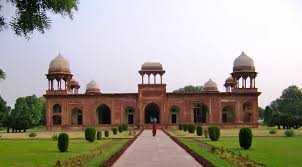
10. Sadar Bazaar
Sadar Bazaar is a bustling market in Agra, known for its vibrant atmosphere and a wide variety of goods. From local handicrafts to delicious street food, this market has something for everyone.
Shopping Hub
Sadar Bazaar is the perfect place to shop for souvenirs and local handicrafts. The market is famous for its leather goods, marble inlay work, and traditional textiles.
Culinary Delights
No visit to Sadar Bazaar is complete without sampling the local street food. Try the famous Agra Petha, a sweet delicacy, and savour the flavours of Mughlai cuisine at the numerous food stalls.
Local Vibes
Sadar Bazaar offers a glimpse into the local life of Agra. The bustling market, vibrant colours, and lively atmosphere make it a must-visit destination for a true cultural experience.

11. Wildlife SOS
Wildlife SOS is a conservation organisation dedicated to rescuing and rehabilitating wildlife in India. Their Agra centre focuses on rescuing elephants and bears, providing a safe haven for these majestic animals.
Conservation Effort
Wildlife SOS is committed to the welfare and conservation of wildlife. Their efforts in rescuing and rehabilitating abused animals have made a significant impact on wildlife conservation in India.
Educational Visit
A visit to Wildlife SOS offers an educational experience, where you can learn about the challenges faced by wildlife and the efforts being made to protect them. The centre provides guided tours and interactive sessions with the animals.
Interactive Experience
Engage with the rescued animals in a responsible manner and learn about their stories. The experience is both heartwarming and enlightening, offering a deeper understanding of wildlife conservation.

12. Kinari Bazaar
Kinari Bazaar is another vibrant market in Agra, known for its exquisite jewellery, textiles, and spices. This traditional market offers a sensory overload with its colourful displays and aromatic spices.
Vibrant Market
Kinari Bazaar is a bustling market that offers a wide range of goods, from intricate jewellery to vibrant textiles. The market is a treasure trove for shoppers looking for unique and traditional items.
Local Experience
Explore the narrow lanes of Kinari Bazaar and immerse yourself in the local culture. The market is a reflection of the rich heritage and craftsmanship of Agra, offering a unique shopping experience.
Shopping Tips
Bargain well to get the best deals and make sure to explore the various shops to find unique items. Kinari Bazaar is a great place to shop for souvenirs and gifts to take back home.

13. Taj Nature Walk
The Taj Nature Walk is a serene walking trail located near the Taj Mahal. This nature reserve offers a peaceful retreat from the bustling city and provides a different perspective of the iconic monument.
Nature’s Retreat
The Taj Nature Walk is a tranquil escape into nature. The trail is surrounded by lush greenery and offers a serene environment for a leisurely walk.
Scenic Beauty
The walk offers stunning views of the Taj Mahal amidst nature. The scenic beauty and the peaceful ambiance make it a perfect spot for relaxation and reflection.
Bird Watching
The Taj Nature Walk is also a great spot for bird watching. The reserve is home to various local and migratory birds, making it a paradise for bird enthusiasts.

14. Mughal Heritage Walk
The Mughal Heritage Walk is an immersive cultural experience that takes you through lesser-known Mughal-era monuments and local communities. This guided walk offers a unique insight into the history and culture of Agra.
Cultural Insight
The Mughal Heritage Walk provides a deeper understanding of Agra’s rich history and cultural heritage. The walk takes you through historical sites and local neighbourhoods, offering a glimpse into the daily life of the residents.
Local Interaction
Engage with local communities and artisans during the walk. Learn about their traditions, crafts, and way of life, and gain a new appreciation for the rich cultural tapestry of Agra.
Authentic Experience
The Mughal Heritage Walk offers an authentic experience that goes beyond the typical tourist attractions. It provides a unique perspective on Agra’s heritage and allows you to connect with the local culture on a deeper level.

Conclusion
Exploring Agra is an experience that blends history, culture, and architectural beauty in a seamless manner. Opting for a Delhi Agra Tour Package is a fantastic way to cover all the major attractions in a well-organized manner, ensuring that you don't miss out on any significant sites.
For those with limited time, a One Day Agra Tour from Delhi offers a perfect opportunity to witness the marvels of Agra in a short span. This tour ensures that you visit the Taj Mahal, Agra Fort, and other key attractions efficiently, making the most of your limited schedule.
If you are seeking a quick and comprehensive experience, the Same Day Agra Tour from Delhi is an excellent option. This tour package is designed for travelers who wish to explore Agra's wonders without the need for an overnight stay, making it convenient and hassle-free.
In conclusion, Agra offers a rich tapestry of history and culture that captivates every visitor. With well-planned tour packages and efficient itineraries, exploring this magnificent city becomes an enriching and memorable experience. Let SRM Holidays be your guide in this journey, ensuring you have an unforgettable and seamless travel experience.
FAQs
1. What are the best times to visit the Taj Mahal for photography?
- Answer: The best times to visit the Taj Mahal for photography are during sunrise and sunset. The soft light during these hours enhances the beauty of the marble monument, creating a golden glow that is perfect for capturing stunning photographs.
2. How much time should I allocate for visiting Agra Fort?
- Answer: Plan to spend at least 1-2 hours exploring Agra Fort. This UNESCO World Heritage Site is vast and rich in history, with numerous palaces, courtyards, and architectural marvels to admire.
3. What is the significance of Fatehpur Sikri in Mughal history?
- Answer: Fatehpur Sikri was the short-lived capital of the Mughal Empire during the reign of Emperor Akbar. It served as a cultural and political center, showcasing Akbar's secular ideals and architectural prowess before being abandoned due to water scarcity.
4. Is Itimad-ud-Daulah's Tomb similar to the Taj Mahal?
- Answer: Itimad-ud-Daulah's Tomb, often called the "Baby Taj," shares similarities with the Taj Mahal in terms of its architectural style and intricate marble inlay work. It predates the Taj Mahal and is considered a precursor to its grandeur.
5. What are some unique experiences to enjoy in Agra beyond the main attractions?
- Answer: Apart from visiting the Taj Mahal and Agra Fort, visitors can enjoy unique experiences such as exploring local markets like Sadar Bazaar and Kinari Bazaar, where they can shop for handicrafts and savor local cuisine. Wildlife enthusiasts can also visit Wildlife SOS to learn about wildlife conservation efforts in the region.








